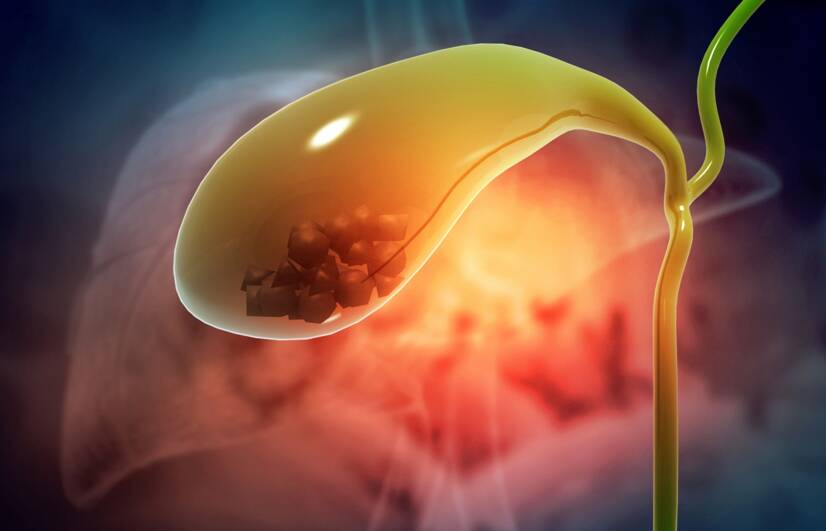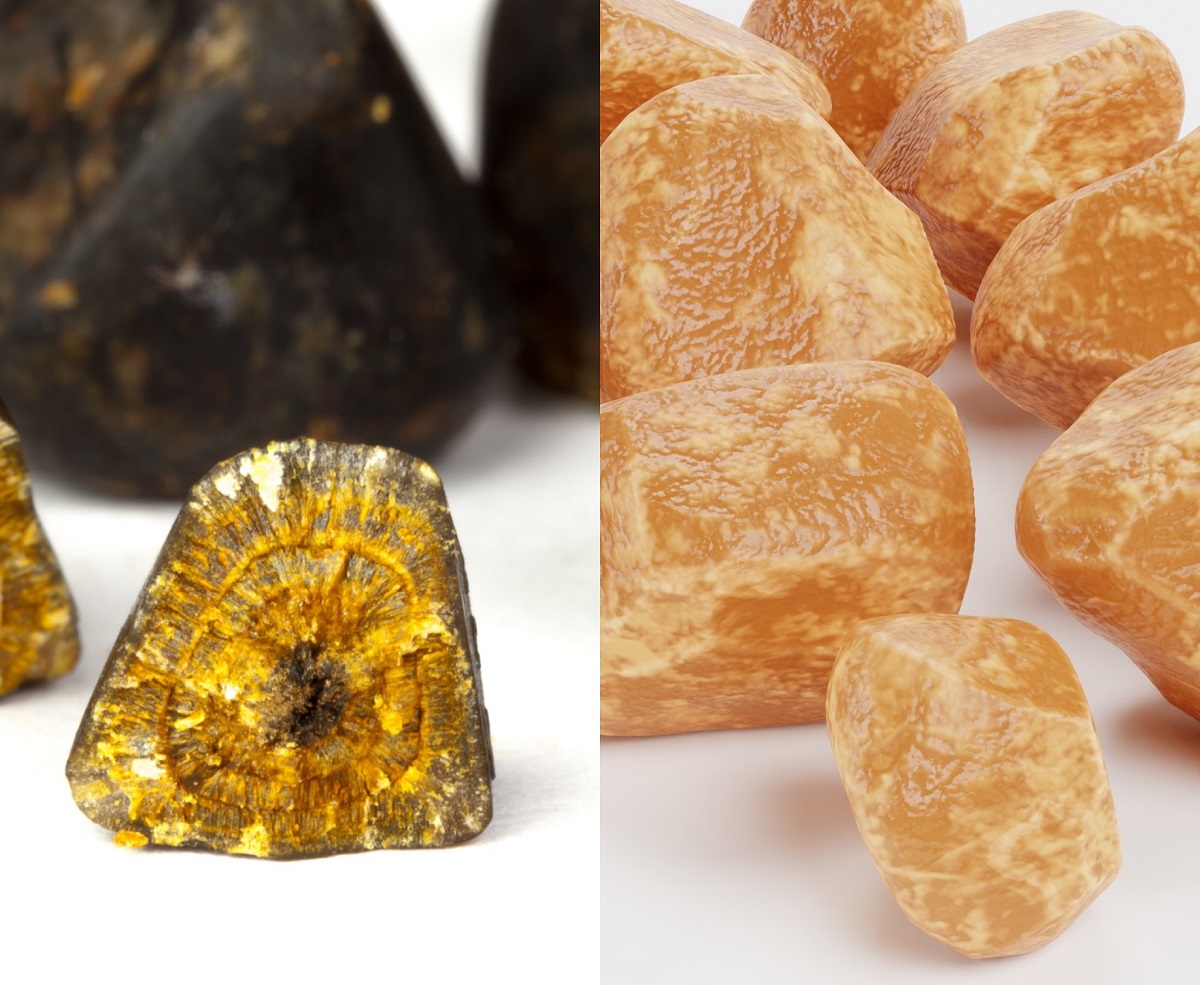- Literature
- Internal Nursing I: Alena Šafránková, Marie Nejedlá
- Modern Obstetrics: Roztočil Aleš a kolektiv
- Obstetrics - 2nd, revised and supplemented edition: Čech Evžen, Hájek Zdeněk, Maršál Karel, Srp Bedřich a kolektiv
- Health and Disease Clinic: Katarína Kopecká, Petr Kopecký
- npz.sk - Gallbladder stones: will diet or surgery solve them?
- adc.sk - Categorization of medicines valid from 1.7.2022
- fmed.uniba.sk - Gallbladder disease, pancreatitis, ileus: MVDr. Katarína Ondičová, PhD. from LFUK, 2020
- revive.sk - Surgeons advise (6).
- healthline.com - Guide to gallbladder stones
- childrensmn.org - Gallstones
- my.clevelandclinic.org - Gallstones
- mayoclinic.org - Gallstones
- medicinenet.com - Who shouldn't take turmeric?
Gallbladder stones: what is it, what are their causes and symptoms?

Gallbladder stones are caused by the formation of concretions in the gallbladder or bile ducts. They usually do not cause any problems. When they become loose and block the bile ducts, various complications can occur.
Most common symptoms
- Shoulder Blade Pain
- Chest pain
- Pain under the left rib
- Right Flank Pain
- Stomach pain after a meal
- Abdominal Pain
- Pain under the right rib
- Pain under the Right Shoulder Blade
- Fever
- Increased body temperature
- Cramps in the abdomen
- Nausea
- Constipation
- Thinning
- Diarrhoea
- Flatulence - bloating
- Sweating
- Bloating - flatulence
- Indigestion
- Low blood pressure
- Heartburn
- Itchy skin
- Tremors
- Fatigue
- Vomiting
- Yellow whites of the eyes
- Stuck winds - stopping the outflow of gases
- Winterreise
- Yellowish skin
- Accelerated heart rate
Characteristics
Gallstones are stones found in the gallbladder. They are formed by precipitation of bile, most commonly cholesterol with calcium salts.
The occurrence of gallstones is one of the common diseases that have a variable course with frequent manifestations of complications.
They are most often formed in adults, but the occurrence in childhood is not an exception.
Women are 2-3 times more likely to develop stones than men. This is mainly related to pregnancy and the use of contraceptive steroids.
It usually forms in the gallbladder (called cholecystolithiasis) and rarely in the bile ducts (called choledocholithiasis). Very rarely it forms in other parts of the bile ducts.
The size of the gallstones can vary from the size of small grains of sand to the size of a small ball. Only one stone can occur, but also many stones at once.
Bile ducts, gallbladder and bile
The gallbladder is a small sac-like organ located in the upper right under the liver. It stores and thickens bile. The gallbladder is part of the biliary system.
Bile is stored in the gallbladder.
Bile is produced by the liver cells. From the liver, it travels through the hepatic ducts to the gallbladder and then through the bile ducts to the small intestine, where it helps in the digestion of fats.
What colour is bile?
The colour of bile varies depending on its contents, such as the pigments bilirubin and biliverdin. Bilirubin is produced when haemoglobin, the red colouring matter of red blood cells, breaks down.
Typically, the colour is yellow, green or even a hint of brown.
In addition to the dyes, bile contains bile salts, fatty acids, fats, cholesterol, electrolytes, minerals and, of course, water.
The pancreatic duct connects to the bile duct just above the small intestine by the pancreatic duct.
After food is eaten and exits the stomach into the duodenum, bile is secreted into the intestine. It aids in the digestion of fats in particular.
A gallstone clogs and stops the flow of bile through the bile ducts. This causes bile to accumulate in the surrounding organs. This creates pressure and pain in the bile ducts and causes inflammation.
Blockage of the bile ducts by gallstones can cause bile to flow into the outlet of the pancreas and stop the secretion of pancreatic juices. This means that the pancreatic juices do not drain and remain in the pancreas.
This causes acute inflammation of the pancreas - pancreatitis.
Causes
The most important thing to reduce the risk of stones is the correct ratio of bile acids to cholesterol in bile.
An important role in the susceptibility to stone formation is played by so-called lithogenic bile, which is supersaturated with cholesterol and has a reduced content of bile acids and phospholipids. Various factors are involved in the lithogenicity of bile.
The accumulation of bile in the gallbladder and its thickening also contribute to the formation of gallstones.
Another factor is the occurrence of chronic inflammatory changes in the gallbladder.
Gallbladder stones affect approximately 10% of adults and 20% of people over 65 years of age.
When do gallstones form?
The cause of gallstones can be:
The bile contains too much cholesterol.
- Under normal conditions, bile contains enough substances to dissolve cholesterol. When cholesterol levels are high, bile is unable to dissolve the excess cholesterol. Cholesterol begins to deposit in small crystals up to the size of stones.
The bile contains too much bilirubin
- Bilirubin is formed when red blood cells break down. Higher levels of bilirubin can form in biliary tract infections, cirrhosis of the liver, but also in blood disorders. Its excess also contributes to the formation of stones.
Improper excretion by the gallbladder
- If the gallbladder does not secrete bile fully or if bile is not secreted frequently, bile accumulates in the bile duct. The bile concentrates and this also contributes to the formation of stones.
What are the types of gallstones?
A gallstone can be a single stone ranging in size from a few millimeters to a size filling the entire gallbladder.
Only one stone can form, but multiple stones of different shapes and sizes can also form.
Concretions are divided into primary and secondary. Primary ones form directly in the bile ducts and secondary ones come out of the gallbladder.
Microlithiasis refers to small stones the size of a pinhead that float freely in the bile or are stuck to the gallbladder from the inside.
Bile sludge is called thickened bile containing bilirubin, cholesterol, calcium salts, mucus droplets, clumps of bacteria and detached cells from the gallbladder wall.
Often this type forms when the gallbladder malfunctions or is associated with inflammation of the gallbladder.
Cholesterol gallstones are yellow in colour and consist of undissolved cholesterol.
Pigment gallstones are coloured dark brown to black. They are formed when there is an excess of bilirubin in the bile.

Other causes involved in the formation of gallstones
- Overeating, overweight, obesity
- Certain medications
- Pregnancy
- Woman especially after childbirth
- 40 years or more
- Sedentary lifestyle
- Consumption of a diet high in fat and cholesterol
- Consumption of a diet low in fibre
- Family history of gallstones
- Diabetes
- Prevalence of blood disorders such as sickle cell anemia, leukemia
- Use of drugs containing estrogens
- Liver disease
Gallstones in children
The cause of gallbladder stones in children is not entirely clear.
They are more common in children:
- Premature births with low birth weight
- After a spinal injury
- After abdominal surgery
- In cystic fibrosis
- Haemolytic anaemia
- Sickle cell anaemia
- Immune system disorder
- Family history of gallstones
Symptoms
Gallbladder stones can manifest themselves in different ways:
Asymptomatic. They are only detected during a casual examination of the abdomen by sonography, CT or MRI.
Gallbladder dyspepsia. Manifested by a feeling of fullness in the abdomen, uncomfortable pressure under the right rib, nausea, bloating, belching, fat intolerance, irregular stools.
However, these symptoms do not indicate the unequivocal presence of gallstones. They can occur even in people without gallstones.
Gallbladder colic, i.e. gallbladder pain, is typical of gallstones.
It is manifested by pain under the right rib or in the epigastrium, sometimes with localization to the left or around the umbilicus.
The pain shoots to the back, to the right side under the scapula or to the shoulder and arm.
The pain may be intense. The person may writhe in pain and be unable to find any position of relief.
Most often the pain appears suddenly, in the evening or at night, but not until an hour after eating.
The duration of the pain is from 1 to 5 hours. It appears most often after a dietary mistake.
It is often associated with a compulsion to vomit or vomiting, which stops the passage of gas.
Vomiting is without a sense of relief. At first there is vomiting of gastric contents and later only bitter gastric juice.
When the bile duct is blocked by a stone, symptoms may appear
- Sudden pain that increases in the right upper abdomen
- Sudden, increasing pain in the middle of the abdomen, below the sternum
- Back pain, often between the shoulder blades
- Pain shooting into the right shoulder
- Nausea and vomiting
- Obstructive icterus - jaundice caused by impaired bile secretion
- Dark-coloured urine
- Fever with chills
What can trigger pain when gallbladder stones occur?
- Consumption of fatty, bulky, hard-to-digest foods such as fried food, duck, eggs, chocolate, mayonnaise, legumes, cabbage
- Excessive physical exertion associated with tremors
- Colds
- Agitation and stress
The frequency of attacks varies. Some people may have a gallbladder attack once in their lifetime, others several times a week. On average, it occurs 1 to 3 times a year.
If gallstones are not treated or diagnosed in time...
Symptoms may include:
- High temperature
- Rapid pulse
- Yellowing of the skin and whites of the eyes
- Feeling itchy skin
- Diarrhea
- Chills
- Loss of appetite
These symptoms can also occur with gallbladder infection, gallbladder inflammation, hepatitis, pancreatitis and can mimic other serious problems.
Symptoms of gallstones in children
Children complain of abdominal pain in the upper right or upper middle part.
The pain is more pronounced after eating, especially if the child has eaten heavier, fatty food.
In addition to the pain, there is also a feeling of nausea, even vomiting.
The child's skin may have a slight yellow tinge to signs of jaundice.
Read also:
Diagnostics
Investigative methods
Abdominal ultrasound is the most commonly used method. It can both detect and capture gallstones. In addition to the stone, thickening of the gallbladder wall can also be detected.
An abdominal X-ray can only detect gallstones of the non-cholesterol type.
CT (computed tomography) is used to view the internal organs. It is one of the radiological examinations that provides more detailed images than an X-ray.
Magnetic resonance cholangiopancreatography (MRCP) allows imaging in any plane with the possibility of layered study. It is used in complicated cholelithiasis, inflammatory changes and biliary diseases.
Endoscopic retrograde cholangiopancreatography (ERCP) is an imaging modality that shows the biliary tract. It also shows the pancreatic duct, which can be used to remove a stone during the examination.
When bile duct enlargement is detected, ERCP is performed.
If ERCP is unsuccessful, PTC (percutaneous transhepatic cholangiography) is performed. PTC is performed by inserting a thin needle into the bile duct outlet from the liver. After administration of a contrast agent, the pathological change located in the bile duct can be pinpointed.
Blood tests can show the presence of infection, jaundice, pancreatitis and other complications associated with gallstones.
Course
They are formed from excess cholesterol or bilirubin.
Their course may be asymptomatic, but they can manifest themselves with various symptoms.
Problems arise when the gallbladder becomes inflamed or the stones break loose from the gallbladder and cause life-threatening conditions.
Complications of gallstones
Inflammation of the gallbladder
When a stone gets stuck, bile returns to the gallbladder. This causes inflammation of the gallbladder. Over time, the gallbladder can become damaged, scarring its tissue and stopping its function.
Inflammation of the gallbladder occurs especially when a stone gets stuck in the neck of the gallbladder. The inflammation causes severe pain and fever.
Blockage of the bile duct
When the bile duct is blocked by a stone, the flow of bile, which carries bile from the liver or gallbladder to the small intestine, is restricted or stopped. It is manifested by severe pain, jaundice and bile duct infection.
Blockage of the pancreatic duct
The pancreatic duct is a tube draining the pancreatic conditions secreted by the pancreas and connecting to the bile duct just before entering the duodenum.
Pancreatic juices help in digestion.
Blockage of this duct leads to pancreatitis, which causes severe, intense abdominal pain and requires hospitalisation.
Cancer of the gallbladder
People with gallbladder stones have an increased risk of gallbladder cancer. However, the likelihood of developing cancer is still small.
The occurrence of gallstones in pregnancy
During pregnancy, gallbladder and biliary tract diseases often occur.
Gallstones in pregnancy are the cause of yellowing of the skin and whites of the eyes in 7%.
The gallbladder in pregnancy changes its position and is displaced due to the growing uterus. This also makes it difficult for the bile to drain.
In pregnancy, the function of the gallbladder and bile ducts is affected. This often leads to the initial formation of gallstones.
In pregnancy, the activity of the gallbladder is reduced. Therefore, gallstones do not manifest themselves and remain mute.
Gallstones are more likely to form in obese multiparous women, in older parturients and in women who have had gallbladder problems before pregnancy.
Cholesterol is involved in the formation of gallstones. Cholesterol causes an increase in its level in pregnancy and an imbalance between cholesterol and gallbladder stabilizers, especially phospholipids and gallbladder salts.
In pregnancy up to 36 weeks gest ation, the gallbladder doubles in volume. The hormone progesterone slows its shrinkage, contributing to the asymptomatic course of gallstones.
Gallbladder pain in pregnancy is not uncommon, especially after eating fatty foods.
Pain under the right rib arch or under the sword-like process of the sternum in the middle of the chest is typical. It may also present with bilateral fluttering pain with shooting into the back.
On palpation and on inspiration there is marked pain under the right rib arch.
Symptoms:
- Feeling of fullness in the epigastrium
- Flatulence
- Burping
- Nausea to vomiting
How it is treated: Gallbladder stones - cholelithiasis
How are gallstones treated? Medication, surgery, diet, tea?
Show moreOrigin, manifestations and treatment of gallbladder stones (video)
Gallbladder stones is treated by
Other names
Interesting resources










